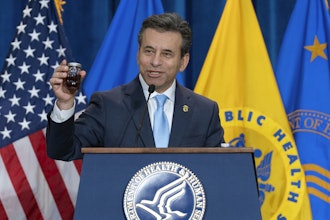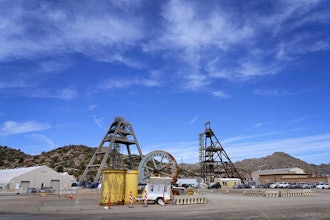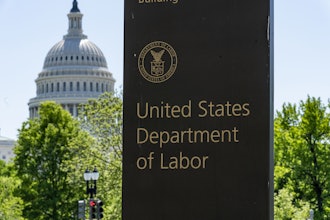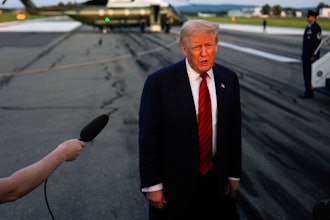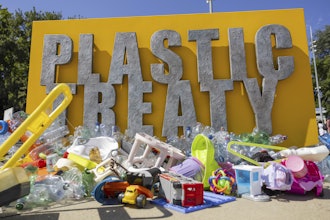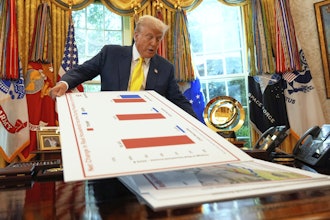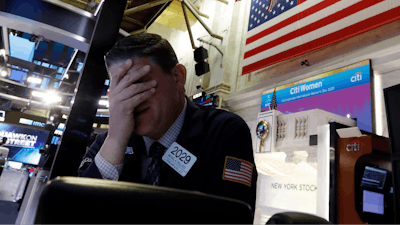
NEW YORK (AP) — Stocks fell sharply Monday on Wall Street on a combination of coronavirus fears and plunging oil prices, triggering a brief, automatic halt in trading to let investors catch their breath.
The price of oil sank nearly 20% after Russia refused to roll back production in response to falling prices and Saudi Arabia signaled that it will ramp up its output.
While low oil prices can eventually translate into cheaper gasoline, they are wreaking havoc on already struggling energy companies and countries that depend on oil, including the No. 1 producer, the United States.
The war between the giant oil producers came just as Italy heads for a huge hit to its economy as it enforces a lockdown on 16 million people in the northern part of the country, the heart of its manufacturing and financial industries. The turmoil is expected to push Italy into recession and weigh on the European economy.
The carnage in other markets was nearly as breathtaking as in oil. U.S. stocks careened closer to a bear market, signified by a drop of 20% from its record, while a measure of fear in the market touched its highest level since the 2008 financial crisis. European stock markets fell even more sharply, and Treasury yields plunged to more record lows in the latest vicious swings for a market that has rocked investors the last couple weeks.
The S&P 500 plunged as much as 7.4% in the first few minutes of trading, and losses were so sharp that trading was temporarily halted. Stocks trimmed their losses following the halt, and the index was down 4.8%, as of 11:44 a.m. Eastern time.
The Dow Jones Industrial Average lost 1,255 points, or 4.9%, to 24,605 after briefly being down more than 2,000. The Nasdaq gave up 4.4%.
The carnage in the energy sector was particularly arresting. Marathon Oil, Apache Corp. and Diamondback Energy each sank more than 40%. Exxon Mobil and Chevron were on track for their worst days since 2008.
“The path of least resistance is still down,” said Liz Ann Sonders, chief investment strategist at Charles Schwab.
Treasury yields careened lower as investors dove into anything that seems safe, even if it pays closer to nothing each day. Traders are increasing bets that the Federal Reserve will cut interest rates back to zero to do what it can to help the virus-weakened economy, perhaps as soon as next week.
All the drops are the result of fear of the unknown. As COVID-19 spreads around the world, many investors feel helpless in trying to estimate how much it will hurt the economy and corporate profits, and the easiest response to such uncertainty may be to get out. After initially taking an optimistic view on the virus — hoping that it would remain mostly in China and cause just a short-term disruption — investors are realizing they likely woefully underestimated it.
The virus has infected more than 110,000 worldwide, and Italy on Sunday followed China’s lead in quarantining a big swath of its country in hopes of corralling the spread. That sparked more fears, as quarantines would snarl supply chains for companies even more than they already have.
The new coronavirus is now spreading on every continent except Antarctica and hurting consumer spending, industrial production, and travel.
Many analysts and professional investors say they expect big swings to continue to dominate the market as long as the number of new virus cases is accelerating.
Including Monday's drop, the S&P 500 has now lost 16.5% since setting a record last month. If it hits a 20% drop, it would mean the death of what’s become the longest-running bull market for U.S. stocks in history. Monday actually marks the 11th anniversary of the market hitting bottom after the 2008 financial crisis.
A measure of fear in the U.S. stock market soared to its highest level since 2008. That means traders are more worried about upcoming swings in the S&P 500 now than they were during the European debt crisis, the U.S.-China trade war or at the height of recession worries after the Federal Reserve raised rates four times in 2018.
The circuit breaker tripped in the U.S. stock market is meant to slow things down and give investors a chance to breathe before trading more.
The yield on the 10-year Treasury note plunged to 0.59%, down sharply from 0.70% late Friday. Early last week, it had never been below 1%.
Short-term yields sank as traders placed increasing bets that the Federal Reserve will cut rates deeper to do what it can to help the economy. The two-year Treasury yield, which moves more on expectations of Fed action, fell to 0.40% from 0.46%.
The Federal Reserve and other central banks around the world have provided the ultimate backstop in the past during this bull market, supporting markets with rate cuts and other measures of stimulus. But doubts are rising about how effective lower rates can be this time. They can encourage people and companies to borrow, but they can't restart factories, restaurants or theme parks shut down because people are quarantined.
The Federal Reserve has already cut its benchmark short-term rate to a range of 1% to 1.25%, leaving it little room to cut more. Traders are pricing in a nearly 50% probability that the Fed will cut to a range of zero to 0.25% at its meeting next week.
“Central banks are a bit player in the current crisis,’’ Ethan Harris, global economist at Bank of America, wrote in a research report.
That's why clamoring is growing louder for help from authorities besides central banks.
“Today’s market action may bang some heads together and actually start thinking about the constructive measures the government can take,’’ said Jacob Kirkegaard, senior fellow at the Peterson Institution for International Economics.
Among other things, Kirkegaard said, the government should make sure all Americans get paid sick leave and health care coverage for virus-related issues.
Brent crude, the international standard, lost $8.50, or 18.8%, to $36.77 per barrel. Benchmark U.S. crude fell $7.35 to $33.93.
Investors were already knocking oil down because of worries that a virus-weakened global economy will burn less fuel. But concerns about supply dropped the latest scythe on the market Monday. Reports that Saudi Arabia may increase production of oil to grab market share led to worries that the world may soon be awash in too much oil.
















